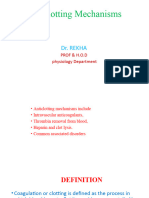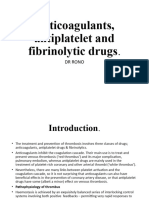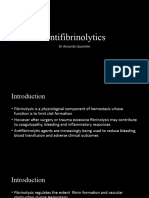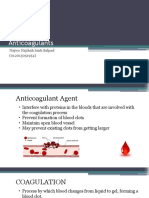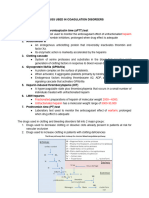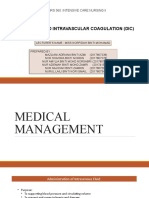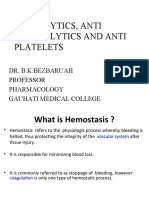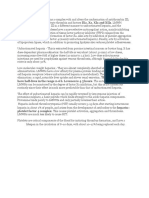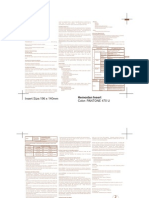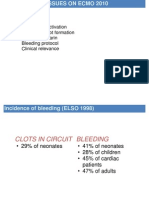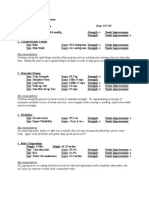0 ratings0% found this document useful (0 votes)
44 viewsReptilase: Haemocoagulase 1 NIH Unit
Reptilase: Haemocoagulase 1 NIH Unit
Uploaded by
kyawkyawhtayHaemocoagulase is a mixture of purified enzymes from the venom of the South American viper Bothrops atrox. It contains enzymes that promote blood coagulation by accelerating the conversion of prothrombin to thrombin and directly transforming fibrinogen to fibrin. Haemocoagulase shortens bleeding and clotting time by promoting coagulation at bleeding sites to reduce blood loss, without causing intravascular coagulation. It is used therapeutically to treat various medical, surgical and dental hemorrhages.
Copyright:
Attribution Non-Commercial (BY-NC)
Available Formats
Download as PPT, PDF, TXT or read online from Scribd
Reptilase: Haemocoagulase 1 NIH Unit
Reptilase: Haemocoagulase 1 NIH Unit
Uploaded by
kyawkyawhtay0 ratings0% found this document useful (0 votes)
44 views21 pagesHaemocoagulase is a mixture of purified enzymes from the venom of the South American viper Bothrops atrox. It contains enzymes that promote blood coagulation by accelerating the conversion of prothrombin to thrombin and directly transforming fibrinogen to fibrin. Haemocoagulase shortens bleeding and clotting time by promoting coagulation at bleeding sites to reduce blood loss, without causing intravascular coagulation. It is used therapeutically to treat various medical, surgical and dental hemorrhages.
Original Description:
Original Title
Reptalase
Copyright
© Attribution Non-Commercial (BY-NC)
Available Formats
PPT, PDF, TXT or read online from Scribd
Share this document
Did you find this document useful?
Is this content inappropriate?
Haemocoagulase is a mixture of purified enzymes from the venom of the South American viper Bothrops atrox. It contains enzymes that promote blood coagulation by accelerating the conversion of prothrombin to thrombin and directly transforming fibrinogen to fibrin. Haemocoagulase shortens bleeding and clotting time by promoting coagulation at bleeding sites to reduce blood loss, without causing intravascular coagulation. It is used therapeutically to treat various medical, surgical and dental hemorrhages.
Copyright:
Attribution Non-Commercial (BY-NC)
Available Formats
Download as PPT, PDF, TXT or read online from Scribd
Download as ppt, pdf, or txt
0 ratings0% found this document useful (0 votes)
44 views21 pagesReptilase: Haemocoagulase 1 NIH Unit
Reptilase: Haemocoagulase 1 NIH Unit
Uploaded by
kyawkyawhtayHaemocoagulase is a mixture of purified enzymes from the venom of the South American viper Bothrops atrox. It contains enzymes that promote blood coagulation by accelerating the conversion of prothrombin to thrombin and directly transforming fibrinogen to fibrin. Haemocoagulase shortens bleeding and clotting time by promoting coagulation at bleeding sites to reduce blood loss, without causing intravascular coagulation. It is used therapeutically to treat various medical, surgical and dental hemorrhages.
Copyright:
Attribution Non-Commercial (BY-NC)
Available Formats
Download as PPT, PDF, TXT or read online from Scribd
Download as ppt, pdf, or txt
You are on page 1of 21
Reptilase
Haemocoagulase
1 NIH unit
Troikaa P’cals Ltd, India
Reptilase
• Haemocoagulase is a mixture of purified
enzymes isolated from the venom of South
American viper, called Bothrops atrox. It is
completely free of neurotoxins and other toxic
substances
• A proteolytic enzyme obtained from the
venom of fer-de-lance (Bothrops atrox). It is
used as a plasma clotting agent for fibrinogen
and for the detection of fibrinogen
degradation products
• Haemocoagulase has two different enzymatic
activities, which promote blood coagulation
• One accelerates conversion of prothrombin to
thrombin (thromboplastin like enzymes)
• Other one causes a direct transformation of
fibrinogen to fibrin monomer, which can be
converted by thrombin into fibrin clot (thrombin like
enzymes)
• In-vitro, the thrombin like enzyme coagulates
fibrinogen by gradually splitting off
fibrinopeptide A, in contrast to thrombin,
which removes both fibrinopeptides A and B.
This give rise to des-A-fibrin monomers, which
polymerize end-to-end to form fibrin clot.
• However, unlike thrombin, the thrombin like
activity of Haemocoagulase is not inhibited by
antithrombins such as heparin. In the circulating
blood, the des-Afibrin monomer produced by
Haemocoagulase remains in solution because it
forms a complex with native fibrinogen. These
complexes of high molecular weight accelerate
the platelet aggregation and reduce capillary
permeability at the site of the vascular injury.
• The thromboplastin enzyme activates Factor X,
essentially in the presence of factor III, released
from platelets aggregated at the bleeding site.
The activated Factor Xa then supports thrombin
formation at the site of hemorrhage.
• However, in vitro, thromboplastin like enzymes
can convert prothrombin to thrombin, even in
the absence of Factor III and Factor X.
• Thus Haemocoagulase shortens the bleeding
and clotting time, by promoting coagulation at
bleeding sites and reduces blood loss.
Haemocoagulase in therapeutic doses does
not cause intravascular coagulation, and only
promotes the physiological processes of
hemostasis.
• Following intravenous administration, the
hemostatic effect becomes apparent after 5 to
10 minutes and lasts for 24 hours. After
intramuscular or subcutaneous
administration, the action starts after 20 to 30
minutes and the duration of action is 48 to 60
hours. After local spraying or applying soaked
swab on the bleeding surface, the action
starts within a minute.
• 20 minutes after the injection of 1 unit of this
product, bleeding time for healthy adults is
measured to shorten by 1/2 to 2/3. This
clinical effect will last 2 to 3 days.
• This product only functions on bleeding stop
with no effect on blood thrombin quantity. So
there is no possibility of forming thrombus by
using this product.
• Haemorrhages of diverse aetiology of medical,
surgical,gynaecological and dental origin
• Thrombotic or embolic episodes.
• Adult :1ml by IM/IV/SC
• Children:0.3ml 0.5ml.
• [Forbidden Group]:
1. Thrombus patients or thrombus history
patients although there is no report of
forming thrombus by using this product.
2. Patients allergic to this product or
similar products.
• [Notice]:
1. Pregnant women are not suggested to use this product unless it’s urgent.
2. Dispersed Intra blood vessel Coagulation (DIC) or blood disease patients are not
suggested to use this product.
3. When lack of blood platelet or blood coagulation agent such as thrombin
proenzyme, this product is not a substitute but should be used after blood platelet
or blood coagulation agent is compensated, or new blood is transmitted.
4. When idiopathy fibrinolytic system is sthenic, for example, after endocrine gland
or cancer operation. This product should be used together with fibrinolysin
medicine.
5. Avoid over dosed. Over dosage will decrease the function of bleeding stop.
6. Observe the situation of bleeding and blood coagulation while treating the
patients.
• It’s very seldom to have side effect.
Occasionally there is allergy. Just treat as
ordinary allergy by using antihistaminic or
similar.
Clinical trials
Competitors
Targeted Dr.
• Physicians
You might also like
- Maharana Pratap College of DentistryDocument24 pagesMaharana Pratap College of DentistryprinceNo ratings yet
- Unit IV Drugs Affecting Hematology SystemDocument54 pagesUnit IV Drugs Affecting Hematology SystemIbrahimNo ratings yet
- Anti Clotting SystemDocument36 pagesAnti Clotting SystemtappetielishaabhishekNo ratings yet
- Antiplatelet, Anticoagulant and Thrombolytic Agents: Basic Pharmacology Block Pdnt/Pmed - PMSC/PPHR - 213Document30 pagesAntiplatelet, Anticoagulant and Thrombolytic Agents: Basic Pharmacology Block Pdnt/Pmed - PMSC/PPHR - 213JedoNo ratings yet
- Blood CoagulationDocument47 pagesBlood Coagulationsadaf.cmw1No ratings yet
- Chhattisgarh Dental College and Research Institute: Seminar Topic: Hemostatic AgentsDocument28 pagesChhattisgarh Dental College and Research Institute: Seminar Topic: Hemostatic Agentsvishal tiwaryNo ratings yet
- Coagulation Cascade: Anticoagulant DrugsDocument14 pagesCoagulation Cascade: Anticoagulant Drugsabdo elbahrawyNo ratings yet
- Anticoagulants, Antiplatelet and Fibrinolytic DrugsDocument20 pagesAnticoagulants, Antiplatelet and Fibrinolytic DrugsBii MarshalNo ratings yet
- Blood Drugs-WPS OfficeDocument15 pagesBlood Drugs-WPS OfficeRubabNo ratings yet
- Anticoagulants, Fibrinolytics, AntiplateletsDocument88 pagesAnticoagulants, Fibrinolytics, Antiplateletspmuawiyah25No ratings yet
- Anticoagulant Powerpoint PresentationsDocument60 pagesAnticoagulant Powerpoint PresentationsREETHUNo ratings yet
- Antifibrinolyitc AgentsDocument12 pagesAntifibrinolyitc Agentsgony1No ratings yet
- AntiplateletDocument27 pagesAntiplateletSubha ShankareeNo ratings yet
- Pharm Final Exam NotesDocument26 pagesPharm Final Exam Noteskatiana louis100% (1)
- 18.fibrinolytic (Thrombolytic) AgentsDocument42 pages18.fibrinolytic (Thrombolytic) AgentsAstha ShresthaNo ratings yet
- AnticoagulantsDocument16 pagesAnticoagulantsabhinavmallick203No ratings yet
- General Pharmacology: Pharmacology of The BloodDocument30 pagesGeneral Pharmacology: Pharmacology of The BloodAbeer KhasawnehNo ratings yet
- 34 Drugs Used in Coagulation and Bleeding DisordersDocument94 pages34 Drugs Used in Coagulation and Bleeding DisordersJeanneNo ratings yet
- CoA Dis - RevDocument60 pagesCoA Dis - RevAzra Al AmanahNo ratings yet
- Anti Clotting, Fibrinolytic, Tests For CoagulationDocument70 pagesAnti Clotting, Fibrinolytic, Tests For CoagulationDr.Gomathi sivakumarNo ratings yet
- Anti Coagulant PRESDocument27 pagesAnti Coagulant PRESenocknyachi6No ratings yet
- Physiology & Pathophysiology of BloodDocument94 pagesPhysiology & Pathophysiology of BloodArwa QishtaNo ratings yet
- AnticoagulantsDocument44 pagesAnticoagulantsdrjscsanjay2225No ratings yet
- Con 1420782810247Document7 pagesCon 1420782810247AsetonitrileNo ratings yet
- Coagulation DisorderDocument38 pagesCoagulation DisorderTsegaye HailuNo ratings yet
- Drugs Used in Coagulation DisordersDocument11 pagesDrugs Used in Coagulation Disordersshoaib106muhammadNo ratings yet
- Drugs Used in Coagulation DisordersDocument9 pagesDrugs Used in Coagulation DisorderschichandesuNo ratings yet
- Anticoagulants, Thrombolytics and AntiplateletDocument57 pagesAnticoagulants, Thrombolytics and AntiplateletEsther Agustin100% (2)
- Clinical Applications of Ferric Sulfate in Dentistry: A Narrative ReviewDocument40 pagesClinical Applications of Ferric Sulfate in Dentistry: A Narrative ReviewAnonymous HfJEe9qrNo ratings yet
- Hemostasis and Blood CoagulationDocument35 pagesHemostasis and Blood CoagulationHarun MohamedNo ratings yet
- ICU 2 - Management For DICDocument20 pagesICU 2 - Management For DICNur Aziemah Mohd ZamriNo ratings yet
- First Aid Management of HemorrhageDocument68 pagesFirst Aid Management of HemorrhageAbdulaziz AlharbiNo ratings yet
- Anticoagulants: Dr. Jim AmisiDocument51 pagesAnticoagulants: Dr. Jim AmisiMike AnnisNo ratings yet
- Bleeding and ThrombosisDocument27 pagesBleeding and Thrombosisswathi bsNo ratings yet
- AnticoagulantsDocument30 pagesAnticoagulantsMuhammad Ahmed khanNo ratings yet
- Anticoagulants and CoagulantsDocument31 pagesAnticoagulants and CoagulantsSandra PlausNo ratings yet
- Management of HemorrhageDocument28 pagesManagement of HemorrhageVicky VikasNo ratings yet
- Coagulants and AnticoagulantsDocument29 pagesCoagulants and AnticoagulantsfdamissieNo ratings yet
- Fibrinolytics, Anti Fibrinolytics and Anti Platelets: Dr. B.K.Bezbaruah Professor Pharmacology Gauhati Medical CollegeDocument46 pagesFibrinolytics, Anti Fibrinolytics and Anti Platelets: Dr. B.K.Bezbaruah Professor Pharmacology Gauhati Medical CollegeBidyut BanerjeeNo ratings yet
- Pharma DR - Hussein Drugs Effecting Hemostasis Lec 1Document31 pagesPharma DR - Hussein Drugs Effecting Hemostasis Lec 1rkh647m7szNo ratings yet
- Have Half-Lives in The Range 2 - 6 H. Lovenox Is 4.5 Hours. The Anticoagulant Effect ofDocument37 pagesHave Half-Lives in The Range 2 - 6 H. Lovenox Is 4.5 Hours. The Anticoagulant Effect ofkellixgNo ratings yet
- Pharmacology of The BloodDocument63 pagesPharmacology of The BloodSawsan Z. JwaiedNo ratings yet
- Laboratory Control of Anticoagulant Therapy - PPTX LectDocument69 pagesLaboratory Control of Anticoagulant Therapy - PPTX LectTusabe FredNo ratings yet
- Intravenous Anaesthetics 2Document29 pagesIntravenous Anaesthetics 2Ahlam AliNo ratings yet
- Fibrinolytic and Antiplatelet Drugs 2020 BDS BSCN Online (Compatibility Mode)Document7 pagesFibrinolytic and Antiplatelet Drugs 2020 BDS BSCN Online (Compatibility Mode)ireneNo ratings yet
- Presentation 1Document13 pagesPresentation 1adnanreshunNo ratings yet
- 11-Components of The Haemostatic ResponseDocument45 pages11-Components of The Haemostatic ResponseNipun ShamikaNo ratings yet
- Management of Hemophilia: Dr. Zoona Qazi Post Graduate ResidentDocument33 pagesManagement of Hemophilia: Dr. Zoona Qazi Post Graduate ResidentZuna QaziNo ratings yet
- Fib Rino Ly TicsDocument7 pagesFib Rino Ly TicsamitbelekarworkNo ratings yet
- Tranexamic Acid in Gynaecology & ObstetricDocument26 pagesTranexamic Acid in Gynaecology & ObstetricsivaNo ratings yet
- AnticoagulantDocument47 pagesAnticoagulantasma barhoomNo ratings yet
- 3 - Fibrinolyic SystemDocument37 pages3 - Fibrinolyic SystemRich Darlene Dela CruzNo ratings yet
- Hemostan LineInsert - Asean 2010Document2 pagesHemostan LineInsert - Asean 2010Maybs Palec Pamplona-ParreñoNo ratings yet
- LM 16 Bleeding and ThrombophiliaDocument69 pagesLM 16 Bleeding and ThrombophiliaRafat S ZriqiNo ratings yet
- 11-THROMBOLYTIC Drugs-Ishfaq 2016Document34 pages11-THROMBOLYTIC Drugs-Ishfaq 2016Eni Purwaeni100% (2)
- Anticoagulant PresentationDocument29 pagesAnticoagulant Presentationrozha100% (3)
- Ecmo CoagulationDocument27 pagesEcmo CoagulationblakewilNo ratings yet
- Epbl 2 (Deep Venous Thrombosis)Document7 pagesEpbl 2 (Deep Venous Thrombosis)Noor Ul AminNo ratings yet
- Top 100 Drugs Pocket Reference Guide (2023 Edition)From EverandTop 100 Drugs Pocket Reference Guide (2023 Edition)No ratings yet
- CV2018Document14 pagesCV2018Sandra ZubacNo ratings yet
- Stretch ReflexDocument18 pagesStretch ReflexRonald Susanto BudhyNo ratings yet
- Cuidado Critico HipomagenesmiaDocument3 pagesCuidado Critico HipomagenesmiaFernando CastroNo ratings yet
- BIBC 100 Handout 4Document3 pagesBIBC 100 Handout 4BIBC 100 Structural Biochemistry Spring'11 TA: LydiNo ratings yet
- Fitness Profile Pre AssessmentDocument1 pageFitness Profile Pre Assessmentapi-486325528No ratings yet
- Amber Tools 12Document535 pagesAmber Tools 12Anna VeraNo ratings yet
- Grasshopper DissectionDocument5 pagesGrasshopper DissectionQuinnee VallejosNo ratings yet
- Mphil Qau AdmissionsDocument4 pagesMphil Qau AdmissionsMajid MehmoodNo ratings yet
- RF TurbiDocument2 pagesRF TurbiDinesh SreedharanNo ratings yet
- Lesson Plan On HELLP Syndrome: SGT University Faculty of NursingDocument14 pagesLesson Plan On HELLP Syndrome: SGT University Faculty of Nursingajnesh100% (1)
- Click: Cambridge IGCSE Biology Extended LevelDocument20 pagesClick: Cambridge IGCSE Biology Extended Levelkaziba stephenNo ratings yet
- Alligator Frank Robb's CVDocument1 pageAlligator Frank Robb's CVAdam HarringtonNo ratings yet
- Imb529 XLS EngDocument89 pagesImb529 XLS EngSaurabh MahajanNo ratings yet
- Role of Lactic Acid Bacteria in Food Preservation and SafetyDocument17 pagesRole of Lactic Acid Bacteria in Food Preservation and SafetyNguyễn Quỳnh DaoNo ratings yet
- Exam PaperDocument14 pagesExam PaperNURUL HANANI BINTI ABD RAHMAN MoeNo ratings yet
- J Sci FoodAgric 2000vanillareviewDocument17 pagesJ Sci FoodAgric 2000vanillareviewBryanCoelloNo ratings yet
- Experimental Study of Torsion Field Effect On LifetimeDocument2 pagesExperimental Study of Torsion Field Effect On Lifetimeapi-186101394No ratings yet
- Poster PDFDocument1 pagePoster PDFJannah ZulkefliNo ratings yet
- How The World Was SavedDocument8 pagesHow The World Was SavedBric HackNo ratings yet
- Lab Hema 3-Nap ScoreDocument6 pagesLab Hema 3-Nap ScoreAfifah SyahrinNo ratings yet
- Lab Report 1 Safety Biological Molecules FillableDocument6 pagesLab Report 1 Safety Biological Molecules Fillableapi-433281064No ratings yet
- (FREE PDF Sample) Pharmaceuticals From Microbes The Bioengineering Perspective Divya Arora EbooksDocument53 pages(FREE PDF Sample) Pharmaceuticals From Microbes The Bioengineering Perspective Divya Arora Ebooksushaanseby100% (4)
- 1st Lecture On The Histology of Urinary System by DR RoomiDocument14 pages1st Lecture On The Histology of Urinary System by DR RoomiMudassar RoomiNo ratings yet
- EYE Histology: Dr. OkoloDocument60 pagesEYE Histology: Dr. OkoloAbiola NerdNo ratings yet
- Introduction and History of BacteriologyDocument35 pagesIntroduction and History of BacteriologyjasnaldNo ratings yet
- Answers of MODULE-4-FORENSIC-CHEMISTRYDocument6 pagesAnswers of MODULE-4-FORENSIC-CHEMISTRYBernabe Fuentes Jr.100% (1)
- Inquiry Based Lesson Plan: Teachers: Abigail Vogt Subject: Biology - 10 StandardDocument5 pagesInquiry Based Lesson Plan: Teachers: Abigail Vogt Subject: Biology - 10 Standardapi-279875140No ratings yet
- Hemostasis: Written By: Fayzah Alshammari Date: 06-11-2021Document4 pagesHemostasis: Written By: Fayzah Alshammari Date: 06-11-2021fayzah alshammariNo ratings yet
- Bluebook Test 1 WritingDocument18 pagesBluebook Test 1 WritingLinh ChiNo ratings yet
- Ecological Relationships BridgingDocument19 pagesEcological Relationships BridginggermaniumgalliumNo ratings yet


